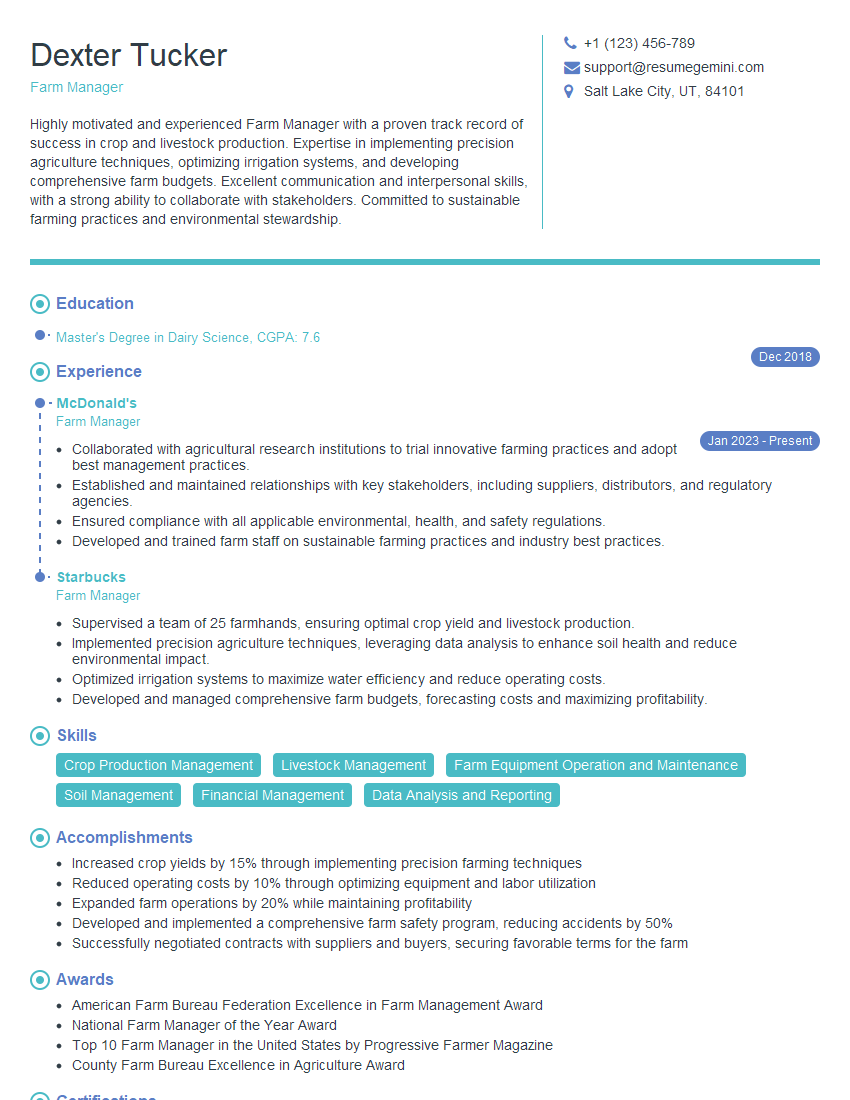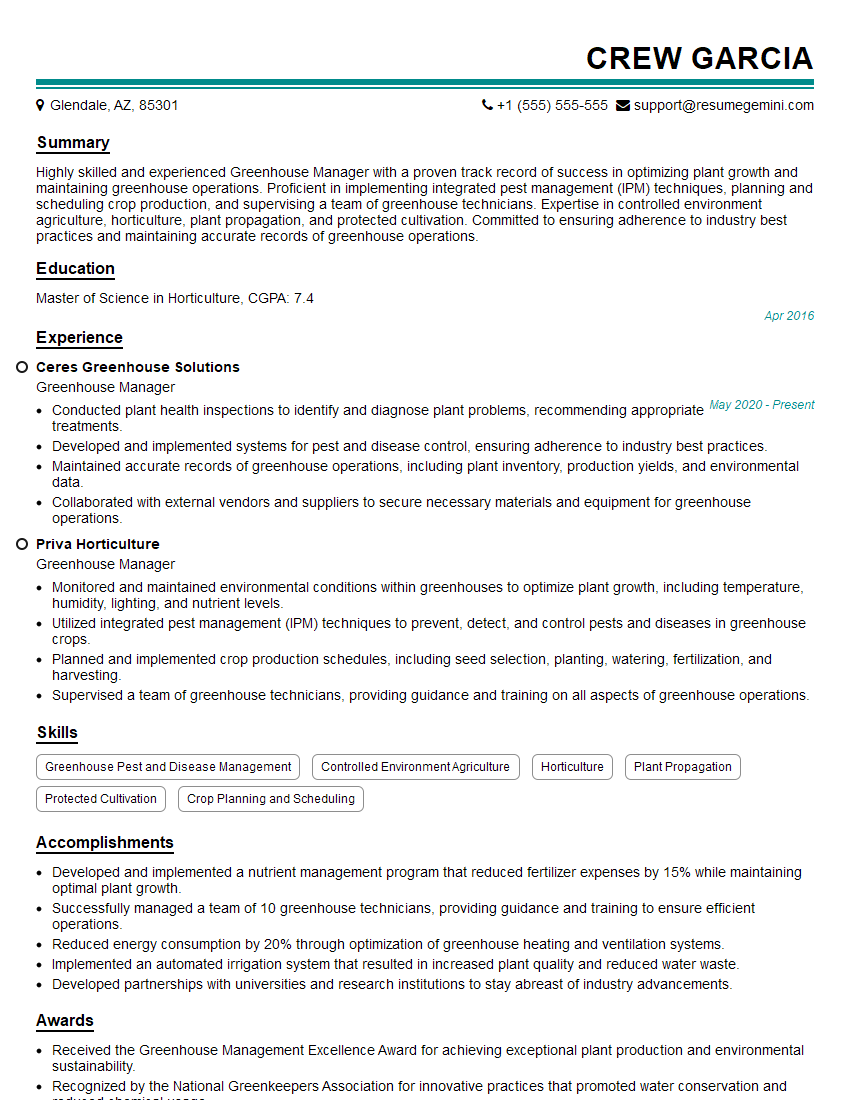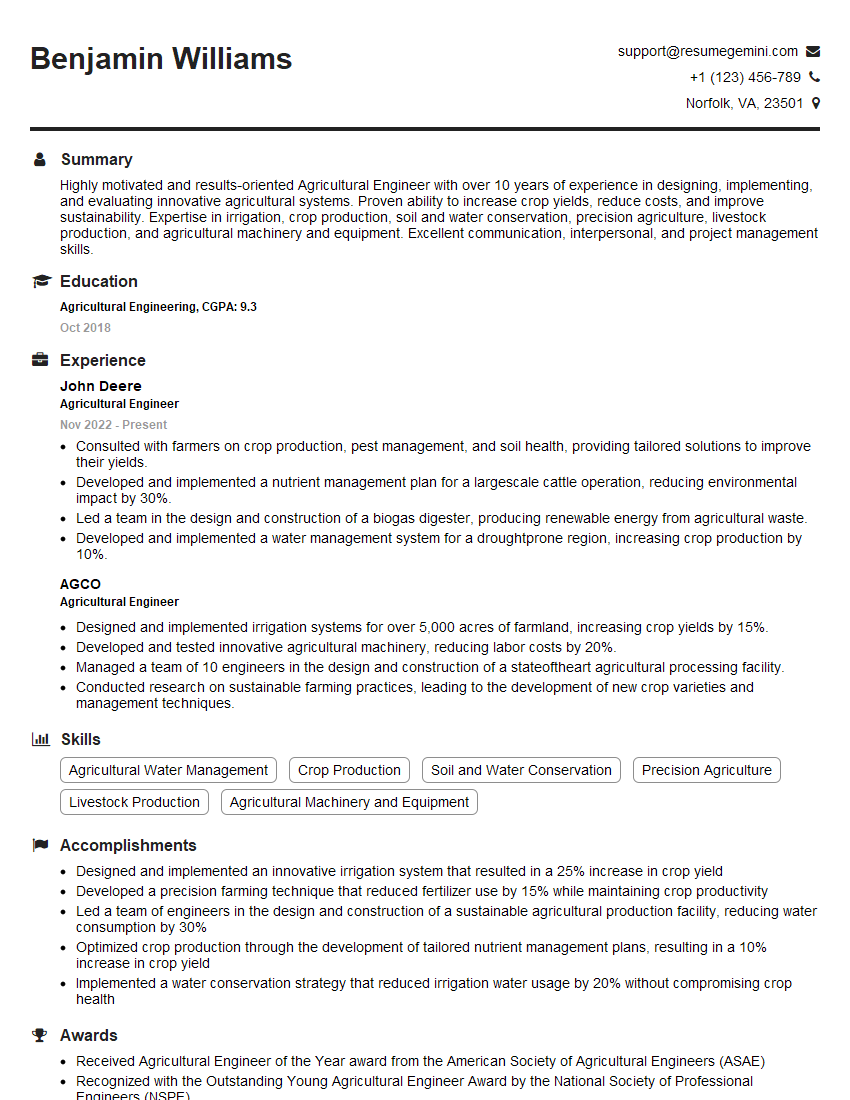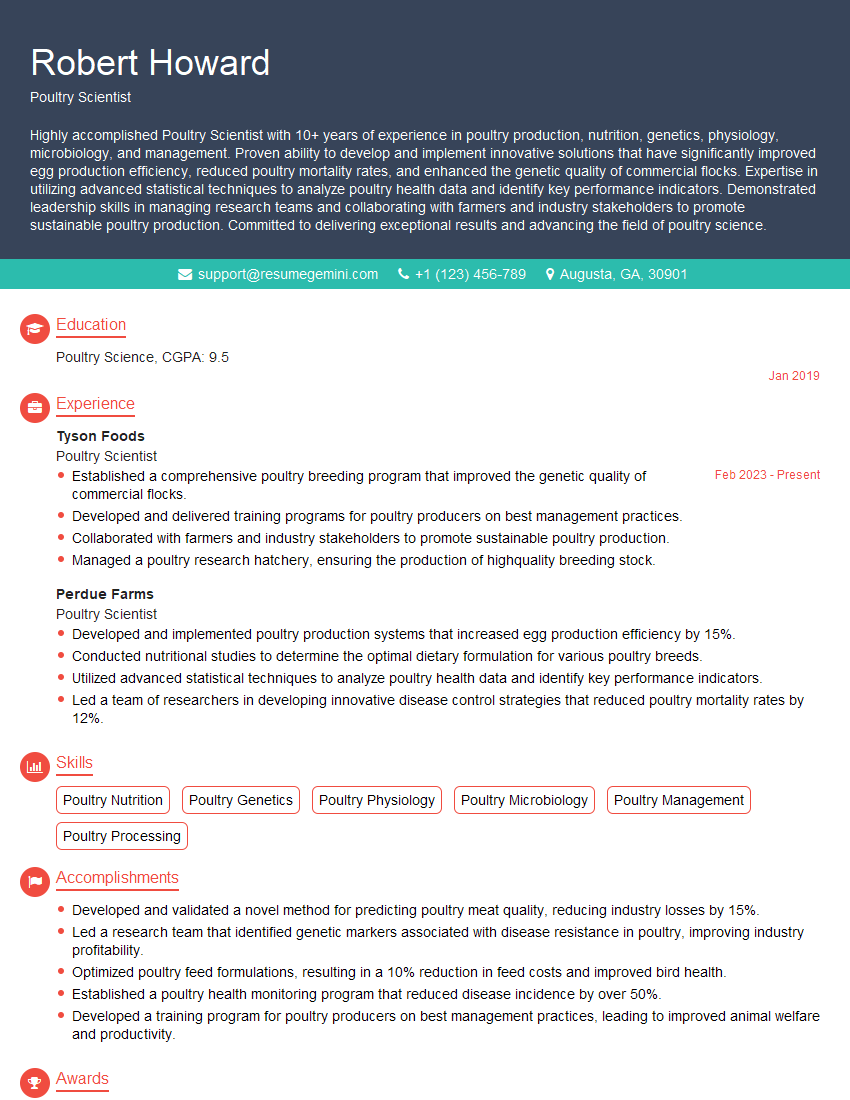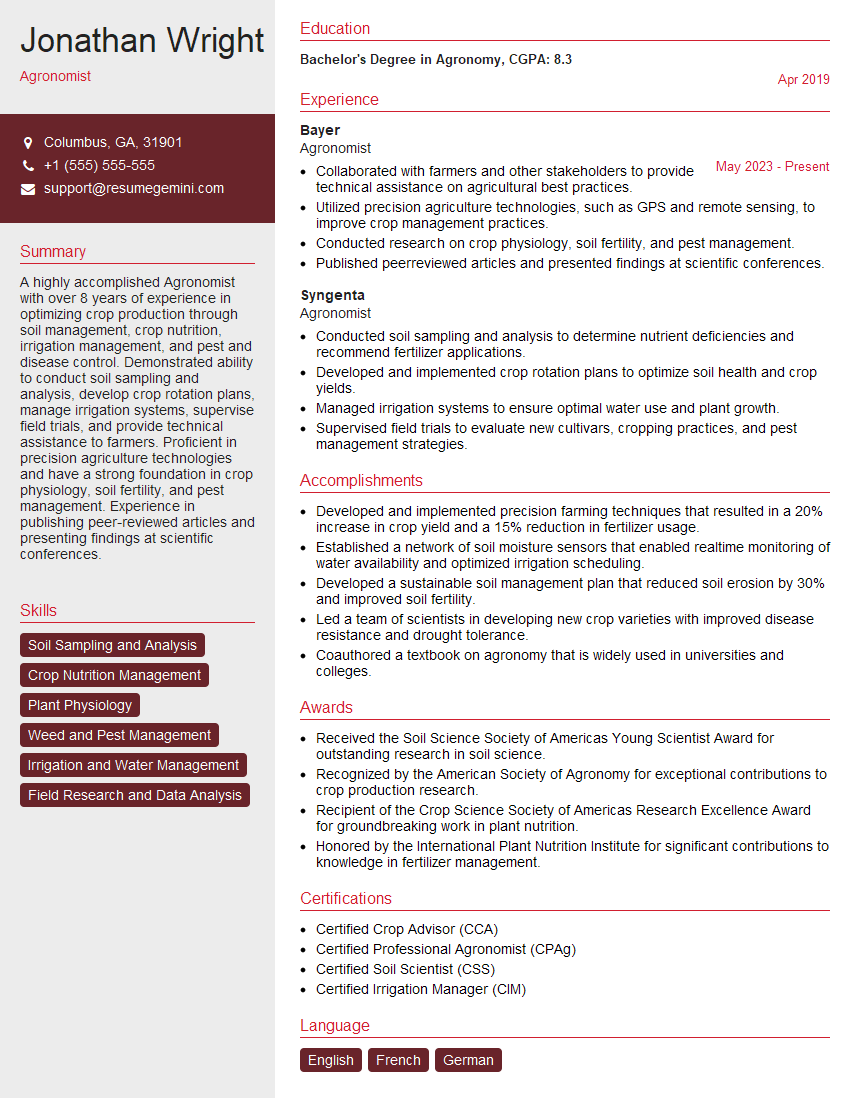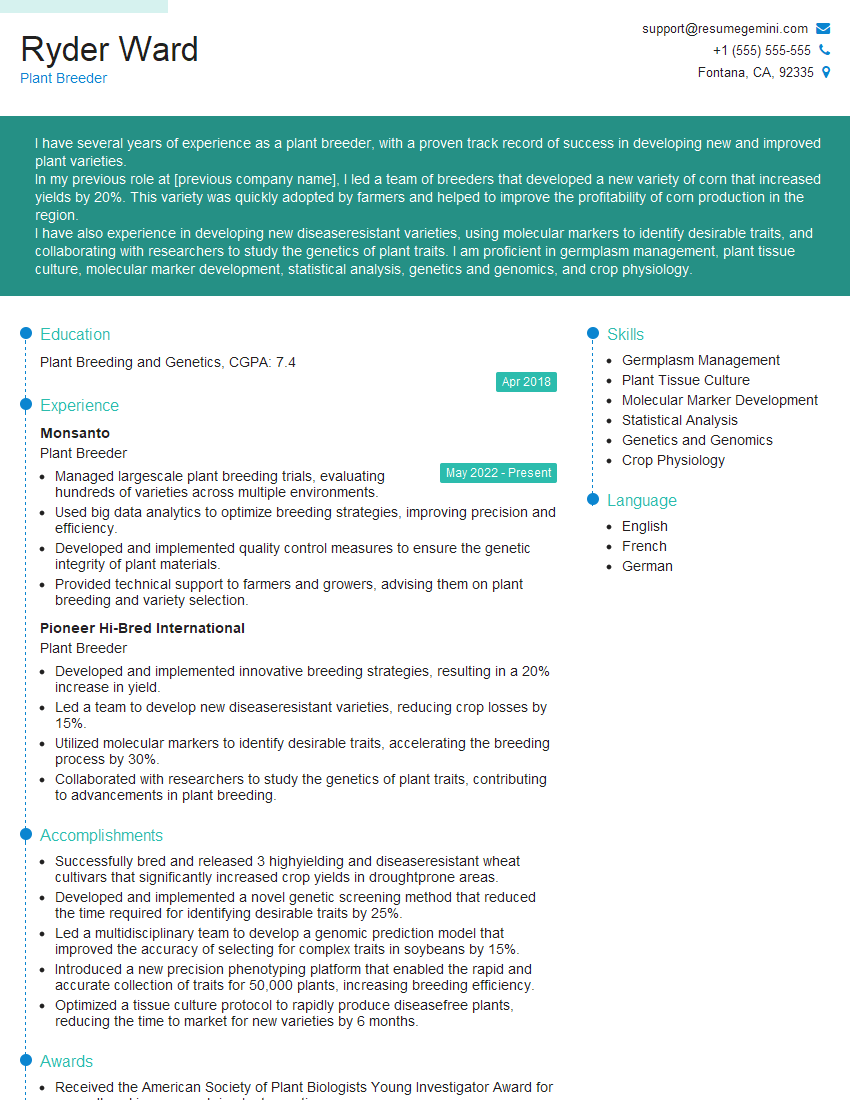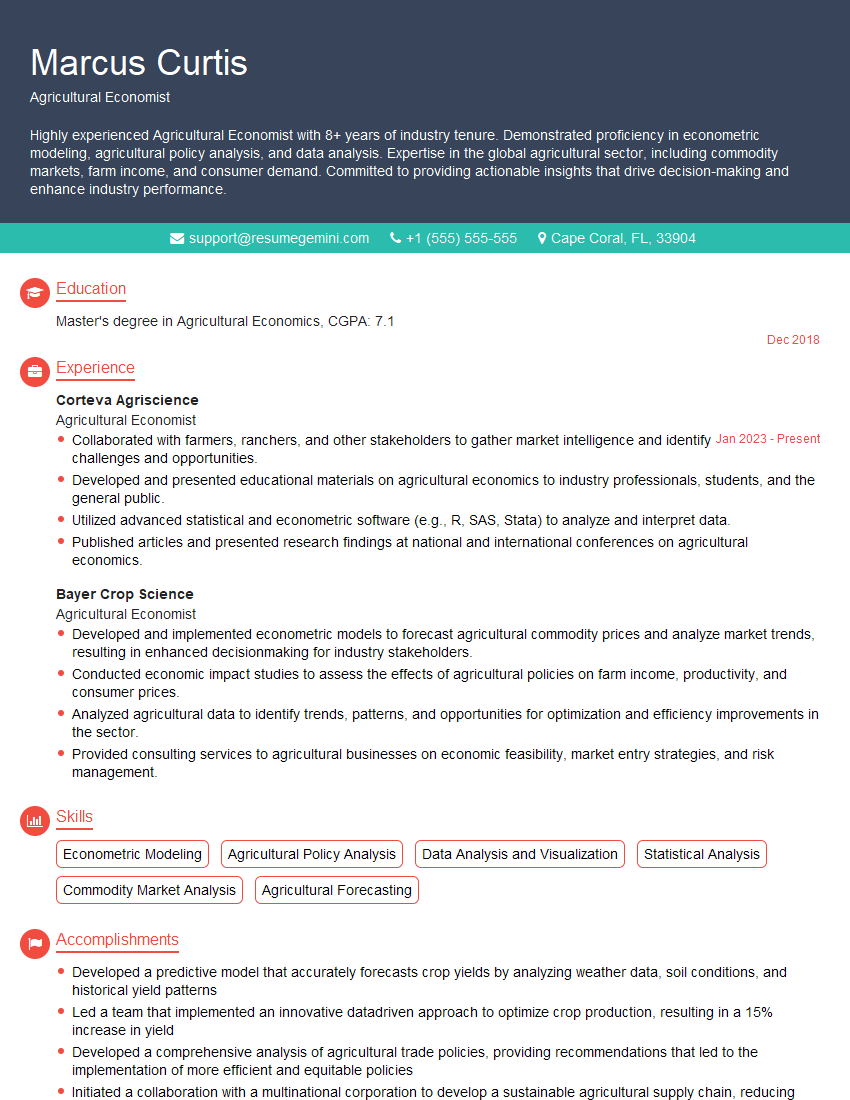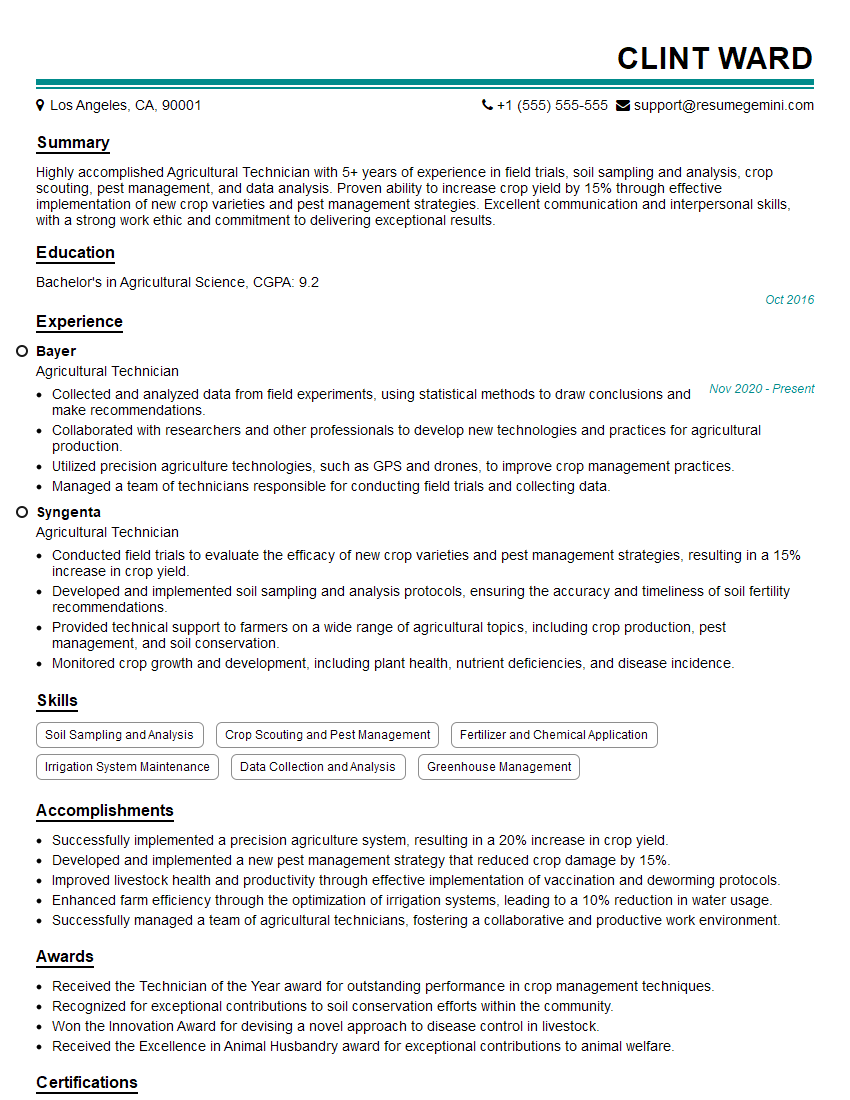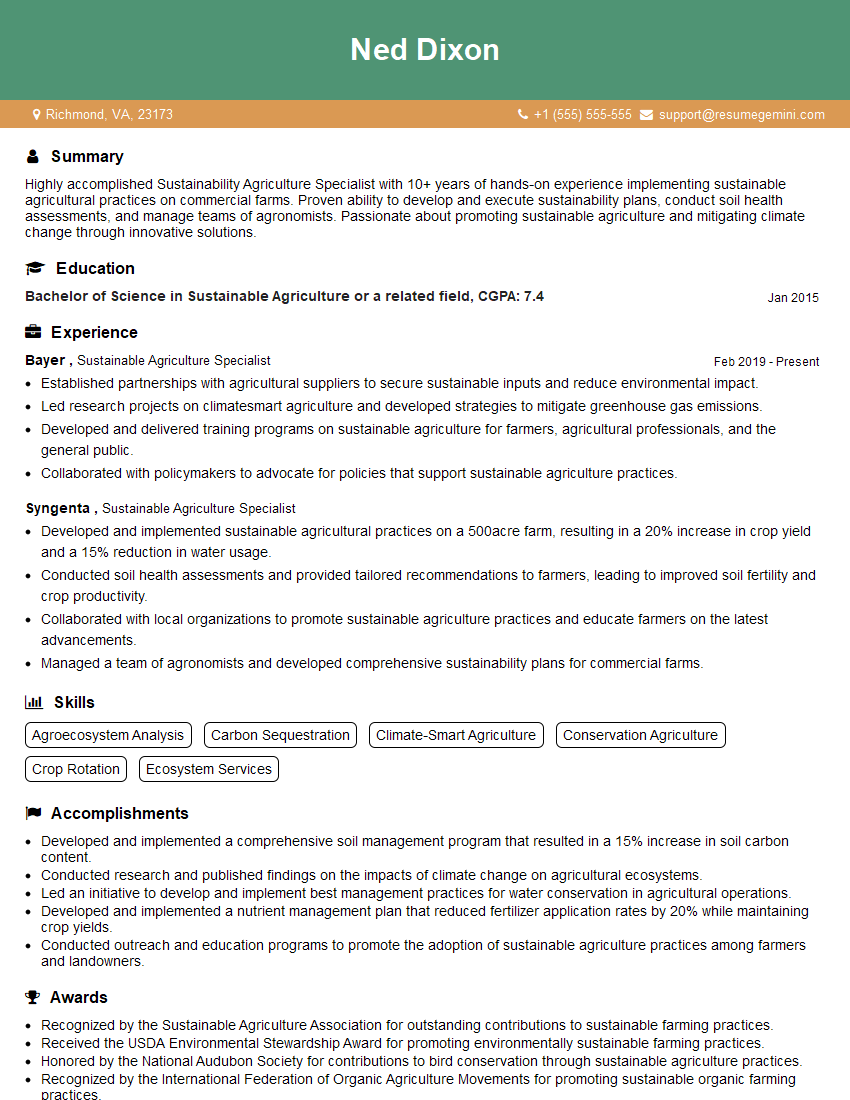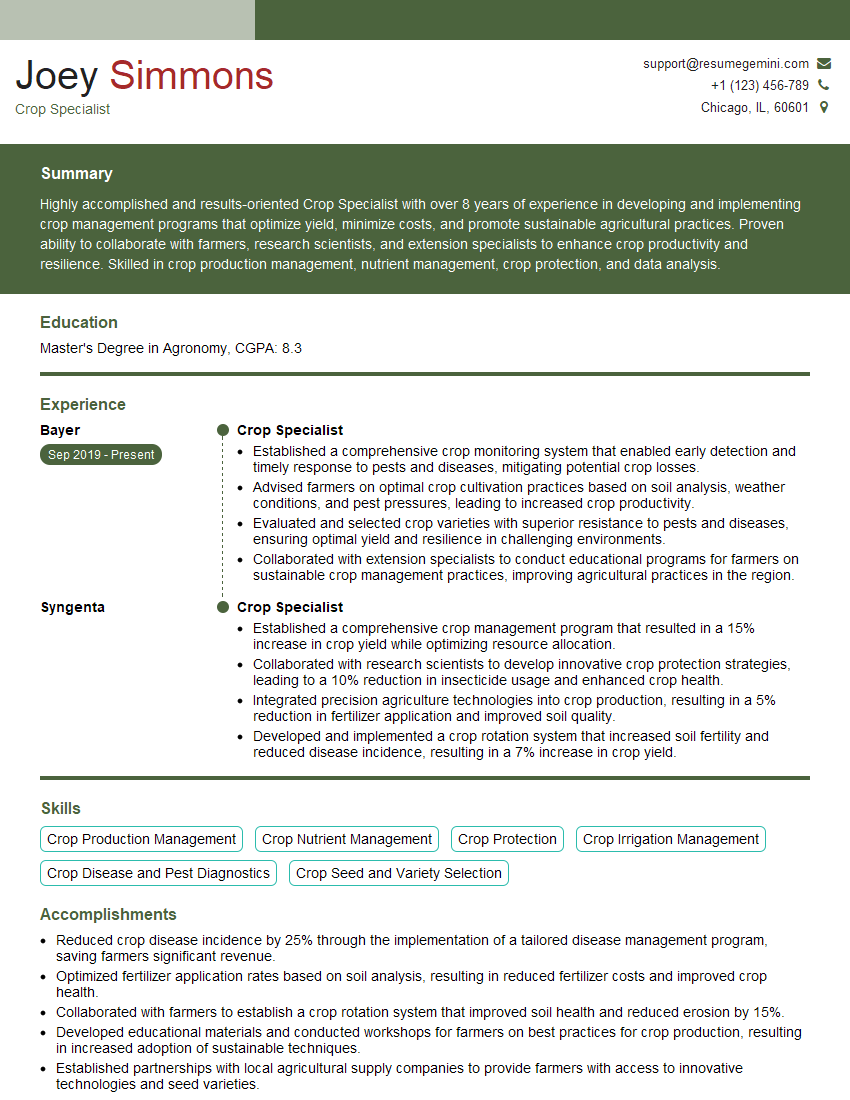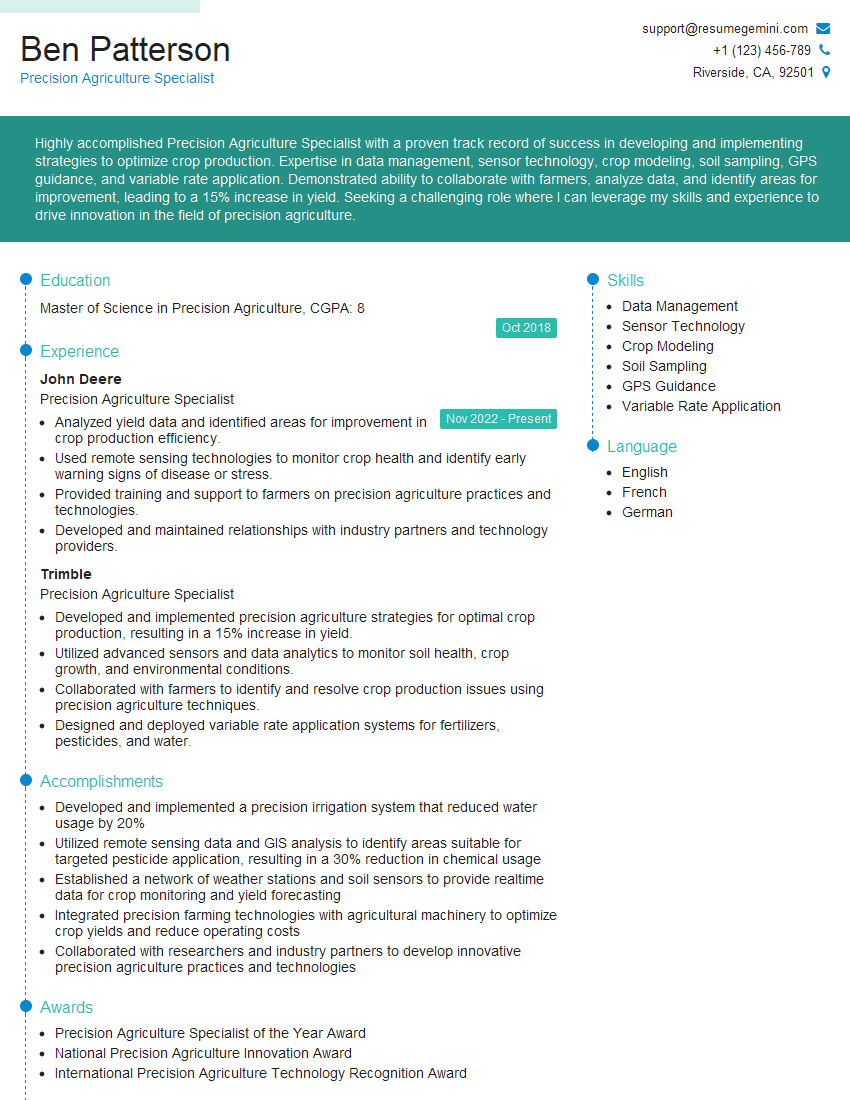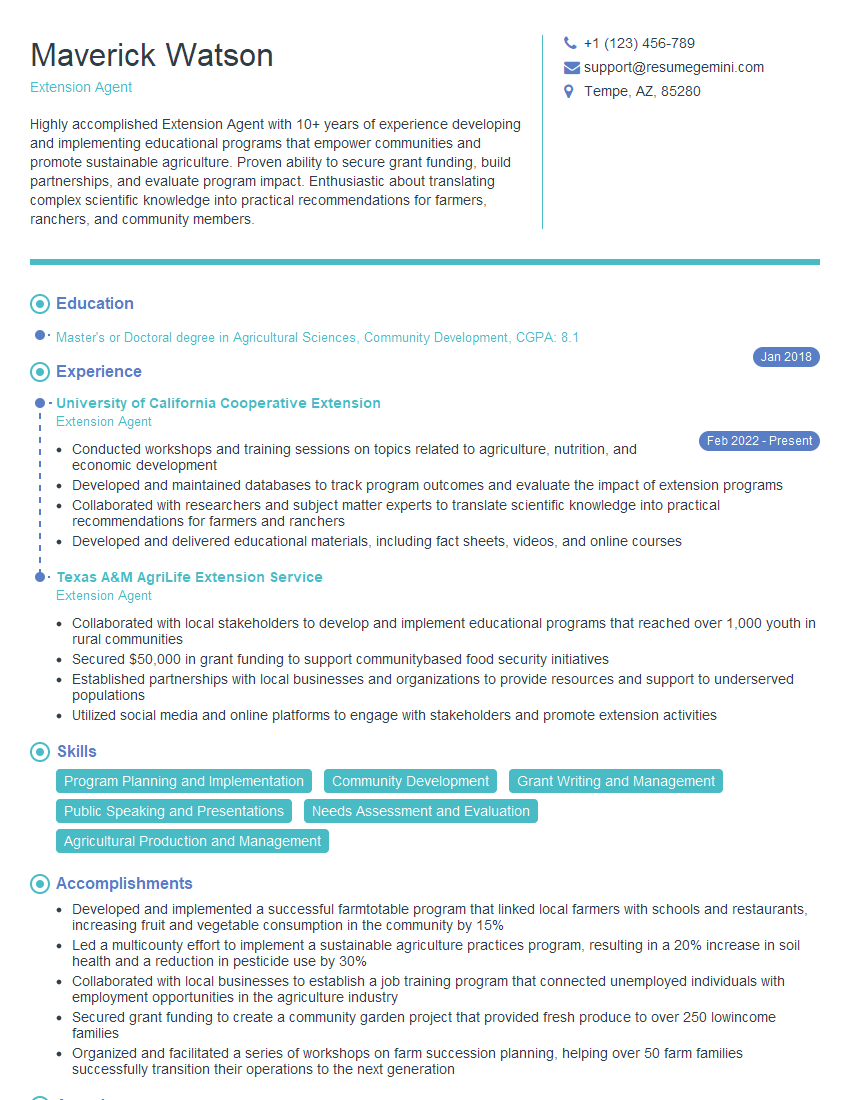Are you ready to stand out in your next interview? Understanding and preparing for Agricultural Science Knowledge interview questions is a game-changer. In this blog, we’ve compiled key questions and expert advice to help you showcase your skills with confidence and precision. Let’s get started on your journey to acing the interview.
Questions Asked in Agricultural Science Knowledge Interview
Q 1. Explain the principles of soil erosion and its control.
Soil erosion is the process where the top layer of soil is detached and transported by natural forces like wind and water. Think of it like a slow, continuous landslide, stripping away the fertile land that supports plant life. This is a serious problem because topsoil is rich in nutrients and organic matter, essential for healthy plant growth. The principles behind it are quite straightforward: Detachment (the breaking up of soil particles), Transportation (movement of particles by wind or water), and Deposition (the settling of eroded soil in a new location).
Controlling soil erosion involves various strategies aimed at minimizing these three processes. These include:
- Contour farming: Planting crops along the contours of slopes, reducing the speed of water runoff.
- Terracing: Creating level platforms on slopes to reduce erosion.
- Crop rotation: Alternating crops with different root systems to improve soil structure and reduce erosion.
- Cover cropping: Planting crops specifically to protect the soil from erosion.
- No-till farming: Minimizing soil disturbance during planting, preserving soil structure.
- Windbreaks: Planting trees or shrubs to reduce wind speed and prevent wind erosion.
- Conservation tillage: Leaving crop residues on the soil surface to protect it from erosion.
For example, a farmer in a hilly region might use terracing to create level fields, preventing water from rushing downhill and carrying away valuable topsoil. Similarly, a farmer in a windy area might plant windbreaks to shield their fields.
Q 2. Describe different methods of irrigation and their suitability for various crops.
Irrigation is the artificial application of water to land to assist in the production of crops. Different methods exist, each with its own advantages and disadvantages, making them suitable for different crops and environments.
- Flood irrigation: Water is released into furrows or over the entire field. Simple and inexpensive but inefficient and can lead to waterlogging.
- Furrow irrigation: Water flows along furrows between crop rows. More efficient than flood irrigation, but some water is lost to evaporation and runoff.
- Drip irrigation: Water is delivered directly to the plant roots through tubes and emitters. Highly efficient, minimizes water waste, and reduces weed growth. Ideal for high-value crops like fruits and vegetables.
- Sprinkler irrigation: Water is sprayed over the field using sprinklers. Suitable for various crops but susceptible to evaporation and wind drift.
- Center-pivot irrigation: A system of sprinklers that rotates around a central pivot, irrigating a circular area. Efficient for large, flat fields.
For instance, drip irrigation is highly suited for orchards because it delivers water precisely where needed, reducing water stress and maximizing fruit production. Conversely, flood irrigation is often used for rice paddies where flooding is a necessary part of the crop’s life cycle.
Q 3. Discuss the impact of climate change on agricultural practices.
Climate change significantly impacts agricultural practices through alterations in temperature, precipitation patterns, and the frequency of extreme weather events. Rising temperatures can shorten growing seasons, reduce crop yields, and increase the incidence of heat stress in plants and livestock. Changes in rainfall patterns, including increased droughts or floods, can disrupt planting schedules, damage crops, and impact water availability for irrigation.
The increased frequency of extreme weather events like heatwaves, droughts, floods, and storms causes significant damage to crops and infrastructure. These events also increase the spread of pests and diseases, adding further challenges to food production.
Farmers are adapting by employing drought-resistant crops, implementing water-efficient irrigation techniques, and improving soil health to enhance resilience to climate change. Precision agriculture technologies, such as sensors and remote sensing, are also being used to monitor crop health and optimize resource use.
For example, farmers in regions experiencing more frequent droughts are switching to drought-tolerant crop varieties and adopting water-saving irrigation systems. In areas with more intense rainfall, they may invest in improved drainage systems to prevent waterlogging.
Q 4. Explain the role of nitrogen fixation in plant growth.
Nitrogen fixation is the process by which atmospheric nitrogen (N2), which is unusable by most plants, is converted into ammonia (NH3), a form that plants can absorb and utilize for growth. This is a crucial step in the nitrogen cycle, an essential process for life on Earth.
This conversion is primarily carried out by specialized bacteria, such as Rhizobium, which live in the root nodules of leguminous plants (peas, beans, clover, etc.). These bacteria have the unique ability to convert atmospheric nitrogen into ammonia through an enzyme called nitrogenase. Other nitrogen-fixing bacteria live freely in the soil.
The ammonia produced is then used by the plant to synthesize essential amino acids, proteins, and nucleic acids, all vital components for plant growth and development. Without nitrogen fixation, plants would struggle to obtain the nitrogen they need, leading to stunted growth and reduced yields.
The symbiotic relationship between legumes and nitrogen-fixing bacteria is a remarkable example of mutualism in nature. The plant provides the bacteria with carbohydrates, while the bacteria provide the plant with a crucial nutrient. This natural process significantly reduces the need for synthetic nitrogen fertilizers, minimizing environmental impact.
Q 5. What are the different types of pesticides and their mechanisms of action?
Pesticides are substances used to control pests, including insects, weeds, fungi, and other organisms that can damage crops or harm human health. They are categorized into several types, each with different mechanisms of action:
- Insecticides: Control insect pests. Mechanisms include nerve disruption (organophosphates, carbamates), disruption of insect growth (insect growth regulators), and stomach poisons (contact poisons).
- Herbicides: Control weeds. Mechanisms include inhibiting photosynthesis, disrupting hormone production, and interfering with cell division.
- Fungicides: Control fungal diseases. Mechanisms include disrupting fungal cell walls or membranes, inhibiting enzyme function, or interfering with spore germination.
- Rodentides: Control rodents. Mechanisms include anticoagulants that prevent blood clotting, or neurotoxins that affect the nervous system.
It is crucial to understand that each type of pesticide has its own specific mode of action, target organism, and potential environmental impacts. Improper use can lead to resistance development in pests, harm beneficial organisms, and contaminate the environment. Therefore, careful selection and application of pesticides is crucial.
For example, organophosphate insecticides work by inhibiting acetylcholinesterase, an enzyme vital for nerve function in insects, leading to paralysis and death. However, these insecticides can also be toxic to humans and other animals if not handled properly.
Q 6. Describe the process of plant breeding and its importance.
Plant breeding is the science of improving or developing new varieties of plants with desirable traits. This involves selecting plants with superior characteristics and crossing them to combine these traits in their offspring. The process uses genetic principles to create plants with improved yield, disease resistance, nutritional value, and adaptability to different environments.
Traditional plant breeding methods involve selecting and crossing plants with desirable traits over many generations. Modern techniques, such as marker-assisted selection and genetic engineering, accelerate the breeding process and allow for more precise manipulation of plant genes.
The importance of plant breeding cannot be overstated. It plays a crucial role in food security by increasing crop yields, improving nutritional content, and enhancing resilience to pests, diseases, and climate change. For instance, breeding has led to the development of high-yielding wheat varieties that have significantly contributed to global food production. Similarly, breeding has produced disease-resistant banana varieties, preventing devastating crop losses.
Q 7. Explain the principles of integrated pest management (IPM).
Integrated Pest Management (IPM) is a sustainable approach to pest control that combines various strategies to minimize pest damage while minimizing the environmental and health risks associated with pesticide use. It’s a holistic approach, emphasizing prevention and minimizing reliance on chemical controls.
The core principles of IPM include:
- Monitoring: Regularly monitoring pest populations to detect infestations early.
- Economic Threshold: Determining the pest population level at which control measures are economically justified.
- Prevention: Implementing practices that prevent pest infestations, such as crop rotation, resistant varieties, and proper sanitation.
- Cultural Controls: Using agricultural practices to suppress pest populations, such as adjusting planting times and optimizing irrigation.
- Biological Controls: Utilizing natural enemies of pests, such as predatory insects or parasitic fungi.
- Chemical Controls: Using pesticides only as a last resort, and then applying them strategically and judiciously.
IPM avoids the reliance on broad-spectrum pesticides, reducing their negative impacts on the environment and human health. It focuses on creating a balance between pest control and ecological sustainability. A farmer using IPM might first monitor pest levels, then implement cultural controls like proper weed management, and only resort to using pesticides if other methods prove insufficient and the economic threshold is exceeded.
Q 8. What are the key factors influencing crop yields?
Crop yields, the amount of harvested produce per unit area, are influenced by a complex interplay of factors. Think of it like a recipe – you need the right ingredients in the right proportions for a successful outcome.
- Climate: Temperature, rainfall, sunlight duration, and extreme weather events like droughts or floods are paramount. For example, a prolonged heatwave can severely reduce wheat yields.
- Soil: Soil fertility, structure, water-holding capacity, and pH levels significantly impact nutrient availability and root growth. Healthy soil is like fertile ground for success.
- Genetics: The crop variety plays a crucial role. High-yielding, disease-resistant varieties are key to maximizing production. Think of it as selecting the best recipe for your specific needs.
- Nutrient Management: Providing the right balance of essential nutrients (nitrogen, phosphorus, potassium, etc.) is vital. Insufficient nutrients are like missing key ingredients in your recipe.
- Pest and Disease Management: Effective control of pests and diseases minimizes yield losses. This is like protecting your ingredients from spoilage.
- Water Management: Appropriate irrigation techniques ensure optimal water availability, crucial for growth and development. Think of water as the vital liquid that brings the recipe to life.
- Farming Practices: Tillage methods, planting density, weed control, and harvesting techniques all influence yields. This is the skillful preparation and execution of the recipe itself.
Understanding and managing these factors is critical for achieving high and consistent crop yields. For instance, precision agriculture techniques, utilizing sensors and data analytics, help optimize resource use and improve yield prediction.
Q 9. Discuss the importance of soil health and its management.
Soil health is the foundation of sustainable agriculture. It’s the overall capacity of soil to function as a vital living ecosystem that sustains plants, animals, and humans. A healthy soil is like a robust engine for agricultural productivity.
- Importance: Healthy soil provides essential nutrients, water retention, and support for plant roots. It also plays a key role in carbon sequestration and reduces the need for synthetic inputs.
- Management Practices:
- No-till farming: Minimizes soil disturbance, enhancing soil structure and organic matter content. Think of it as leaving the engine’s natural lubrication intact.
- Cover cropping: Planting cover crops between main crops protects the soil from erosion, adds organic matter, and suppresses weeds. This is like regularly servicing your engine.
- Crop rotation: Alternating different crop types improves soil fertility and reduces pest and disease buildup. It’s like giving your engine varied fuel to keep it running smoothly.
- Organic matter amendment: Adding compost or manure improves soil structure, fertility, and water-holding capacity. This is like adding high-quality fuel to your engine.
- Integrated pest management: Using a combination of biological, cultural, and chemical controls to reduce pest populations minimizes the use of harmful chemicals.
By adopting these practices, farmers can improve soil health, reduce environmental impacts, and enhance long-term agricultural productivity. For example, a farmer practicing no-till farming and cover cropping has observed a significant increase in soil organic matter and a reduction in erosion.
Q 10. How do you assess the nutritional needs of a crop?
Assessing crop nutritional needs involves a multi-faceted approach. It’s like conducting a health check-up for your plants.
- Soil Testing: This analyzes the soil’s nutrient content, pH level, and organic matter content. This provides a baseline for determining nutrient deficiencies.
- Plant Tissue Analysis: Analyzing plant tissue samples reveals the actual nutrient uptake by the plant. This helps to identify hidden hunger, where plants may appear healthy but lack crucial nutrients internally.
- Visual Symptoms: Observing plant growth, color, and overall health can indicate nutrient deficiencies. For example, yellowing leaves might point to nitrogen deficiency.
- Yield Monitoring: Tracking crop yields over time can provide insights into the overall nutrient management effectiveness. Low yields might signal a need for adjustments in nutrient application.
- Crop Specific Requirements: Understanding the nutrient requirements for specific crops is crucial. Different crops have different needs, similar to how different people need varied diets.
By combining these methods, a precise fertilization plan can be developed that meets the crop’s specific needs while minimizing environmental impact. For example, a farmer using soil and tissue tests can develop a site-specific fertilizer application plan, reducing the need for over-fertilization.
Q 11. Explain the principles of sustainable agriculture.
Sustainable agriculture focuses on meeting present food and fiber needs without compromising the ability of future generations to meet their own needs. It’s about creating a balanced system that thrives over the long term.
- Environmental Stewardship: Minimizing environmental impact through reduced pesticide and fertilizer use, soil conservation practices, and water resource management.
- Economic Viability: Ensuring profitability and economic resilience for farmers through efficient resource use and diversification.
- Social Equity: Promoting fair labor practices, community involvement, and access to healthy food for all.
Principles include integrated pest management, crop rotation, conservation tillage, water conservation, and the use of renewable energy. Imagine a farm that operates like a well-oiled machine, producing high yields while minimizing its footprint on the environment. This is the essence of sustainable agriculture. For instance, a farmer employing agroforestry techniques integrates trees into their farming system, enhancing biodiversity and improving soil health.
Q 12. Describe different methods of livestock management.
Livestock management encompasses various techniques for raising animals efficiently and sustainably. It’s about providing the best possible care while optimizing production.
- Pasture-Based Systems: Animals graze on pastures, minimizing feed costs and promoting animal welfare. Think of it as providing animals with a natural buffet.
- Intensive Systems: Animals are confined to barns or feedlots, allowing for precise control over feeding and environmental conditions. This offers more control but requires careful management to prevent disease and stress.
- Integrated Systems: Combining livestock and crop production, where animal manure is used as fertilizer. This is a symbiotic relationship, maximizing resource utilization.
- Precision Livestock Farming: Utilizing technology, such as sensors and data analytics, to monitor animal health and behavior, improving overall efficiency and animal welfare. Think of it as using smart technology to optimize animal care.
Choosing the right management system depends on various factors, including the type of animal, available resources, and market demands. For example, a dairy farmer might use a combination of pasture-based grazing and confinement feeding to optimize milk production and animal health.
Q 13. What are the challenges facing modern agriculture?
Modern agriculture faces numerous challenges that require innovative solutions. It’s a field constantly evolving to meet the demands of a growing global population.
- Climate Change: Increased frequency and intensity of extreme weather events, such as droughts and floods, impact crop yields and livestock production.
- Resource Scarcity: Water scarcity, land degradation, and nutrient depletion threaten agricultural productivity.
- Pest and Disease Resistance: Development of resistance to pesticides and disease control measures requires ongoing innovation.
- Food Security: Feeding a growing global population while ensuring equitable access to nutritious food remains a major challenge.
- Economic Viability: Farmers face fluctuating market prices, increasing input costs, and economic uncertainties.
- Environmental Degradation: Intensive agriculture contributes to pollution, biodiversity loss, and greenhouse gas emissions.
Addressing these challenges requires a multi-pronged approach, including sustainable farming practices, technological innovation, policy support, and consumer awareness. For example, developing drought-resistant crop varieties is a crucial step in mitigating the impact of climate change on agriculture.
Q 14. Discuss the role of biotechnology in agriculture.
Biotechnology plays a transformative role in modern agriculture, offering tools to enhance crop productivity, improve nutritional value, and enhance disease resistance. Think of it as using advanced technology to improve our agricultural toolkit.
- Genetic Engineering: Developing genetically modified (GM) crops with improved traits, such as herbicide tolerance, pest resistance, and enhanced nutritional value.
- Marker-Assisted Selection (MAS): Using DNA markers to identify desirable genes in plants, accelerating the breeding process and developing superior varieties.
- Genomics and Bioinformatics: Understanding the genetic makeup of crops and livestock, improving breeding strategies and disease management.
- Biopesticides: Developing environmentally friendly pest control methods using naturally occurring microorganisms.
- Precision Agriculture: Utilizing biotechnological tools for site-specific crop management, optimizing resource use and reducing environmental impact.
Biotechnology offers immense potential to address various agricultural challenges, such as improving crop yields in challenging environments, reducing the need for pesticides, and developing nutritious food crops. For example, the development of golden rice, genetically engineered to produce beta-carotene, addresses vitamin A deficiency in many parts of the world. However, the ethical and social implications of biotechnology need to be considered carefully.
Q 15. Explain the principles of precision agriculture.
Precision agriculture is about using technology to manage crops and livestock more efficiently and sustainably. Instead of a blanket approach, it focuses on site-specific management, meaning different parts of a field receive tailored treatment based on their unique needs. Think of it like giving each plant exactly what it needs, when it needs it, rather than applying the same treatment to the entire field.
- GPS and GIS: These technologies pinpoint the precise location of every part of a field, allowing for variable rate application of inputs.
- Sensors and Data Collection: Sensors in the soil, on machinery, or even drones collect data on factors like soil moisture, nutrient levels, and plant health. This data provides critical insights into the field’s conditions.
- Variable Rate Technology (VRT): This is the application of resources—fertilizers, water, pesticides—at varying rates across a field based on the data collected. For example, a sensor detects a nutrient deficiency in one section, and the VRT system automatically adjusts the fertilizer application to address it.
- Data Analysis and Decision Support Systems: Sophisticated software processes the data, identifies patterns, and makes recommendations for optimizing inputs and managing resources. This can range from suggesting irrigation scheduling to predicting pest outbreaks.
For example, a farmer might use precision agriculture to apply fertilizer only to areas that need it, reducing fertilizer costs and minimizing environmental impact. By precisely mapping the field’s productivity, they can strategically plant different varieties according to each section’s specific conditions.
Career Expert Tips:
- Ace those interviews! Prepare effectively by reviewing the Top 50 Most Common Interview Questions on ResumeGemini.
- Navigate your job search with confidence! Explore a wide range of Career Tips on ResumeGemini. Learn about common challenges and recommendations to overcome them.
- Craft the perfect resume! Master the Art of Resume Writing with ResumeGemini’s guide. Showcase your unique qualifications and achievements effectively.
- Don’t miss out on holiday savings! Build your dream resume with ResumeGemini’s ATS optimized templates.
Q 16. How do you manage water resources in agriculture?
Water resource management in agriculture is crucial for sustainable food production. It involves utilizing water efficiently and minimizing waste. Strategies include:
- Irrigation Scheduling: This involves using soil moisture sensors and weather forecasts to determine when and how much water to apply. Avoid over-irrigation, which leads to waterlogging and nutrient leaching.
- Drip Irrigation and Micro-sprinklers: These techniques deliver water directly to the plant roots, minimizing evaporation and runoff compared to flood irrigation. Think of it like giving plants a drink with a straw instead of pouring water all over the place.
- Water Harvesting and Storage: Collecting rainwater and storing it in reservoirs or tanks provides a supplementary water source during dry periods. This can involve building small dams or using rainwater harvesting systems on farms.
- Drought-resistant Crops: Selecting and cultivating crops that are adapted to dry conditions reduces water needs. This involves understanding the specific water requirements of different crops and selecting the appropriate ones for the climate and soil type.
- Improved Water Management Practices: This includes techniques like contour farming, terracing, and mulching to reduce runoff and enhance water infiltration into the soil. These reduce erosion and improve soil water holding capacity.
For instance, a farmer in a water-scarce region might switch to drought-resistant varieties, implement drip irrigation, and invest in rainwater harvesting to ensure a stable water supply for their crops.
Q 17. Describe the different types of fertilizers and their application.
Fertilizers provide essential nutrients to plants for healthy growth. They are broadly classified as:
- Inorganic Fertilizers (Mineral Fertilizers): These are manufactured from minerals and contain specific ratios of nitrogen (N), phosphorus (P), and potassium (K), often represented as NPK ratios (e.g., 10-10-10). They provide a readily available source of nutrients but can have environmental drawbacks if used improperly.
- Organic Fertilizers: These are derived from organic matter like compost, manure, and bone meal. They release nutrients slowly, improving soil structure and health. They are environmentally friendly but may not provide the immediate nutrient boost inorganic fertilizers offer.
- Biofertilizers: These contain living microorganisms like nitrogen-fixing bacteria or mycorrhizae fungi that help plants access nutrients more efficiently. They enhance soil fertility and are a sustainable alternative.
Application methods:
- Broadcasting: Spreading fertilizer evenly over the entire field. This is suitable for less precise applications.
- Banding: Applying fertilizer in bands near the seeds or plants. This is more efficient as nutrients are placed close to the roots.
- Topdressing: Applying fertilizer to the soil surface after planting.
- Foliar Application: Spraying nutrient solutions directly onto plant leaves. This is useful for quick nutrient uptake.
The choice of fertilizer and application method depends on factors such as crop type, soil conditions, nutrient levels, and environmental considerations. For example, a farmer might use organic fertilizer to improve soil health in the long term and then supplement with inorganic fertilizer for specific nutrient needs.
Q 18. What are the common diseases affecting major crops in your region?
(Note: This answer will need to be customized based on your specific region. I will provide a generalized example.)
Common diseases affecting major crops vary significantly depending on geographical location, climate, and agricultural practices. However, some examples for common diseases affecting major crops include:
- Late blight (Phytophthora infestans) in potatoes and tomatoes: This devastating fungal disease can cause significant yield losses. Early detection and the use of disease-resistant varieties are crucial.
- Rust diseases (various species) in cereals and legumes: These fungal diseases reduce yield and grain quality. Fungicide applications, crop rotation, and resistant varieties can help.
- Bacterial wilt (various species) in various crops: These bacterial diseases affect vascular systems, causing wilting and plant death. Sanitation, crop rotation, and resistant varieties are important management strategies.
- Viral diseases (various species) in many crops: Viruses can severely damage crops. Controlling insect vectors (e.g., aphids) that transmit viruses is essential.
Effective disease management involves a combination of preventative measures (e.g., crop rotation, resistant varieties, good sanitation) and curative measures (e.g., fungicides, bactericides).
Q 19. Explain the importance of post-harvest management.
Post-harvest management encompasses all activities undertaken after harvesting a crop to maintain its quality and prevent losses. It’s just as critical as the growing process itself. Efficient post-harvest management ensures food security, reduces waste, and maximizes farmers’ profits.
- Harvesting Techniques: Careful harvesting minimizes damage to the produce.
- Cleaning and Grading: Removing debris and sorting produce according to quality and size prevents spoilage and enhances marketability.
- Drying and Storage: Proper drying techniques (sun drying, air drying, mechanical drying) reduce moisture content, inhibiting microbial growth. Storage conditions (temperature, humidity, ventilation) are crucial to prevent spoilage.
- Processing and Value Addition: Transforming raw produce into processed products (e.g., jams, pickles) extends shelf life and increases value.
- Transportation and Packaging: Using appropriate containers and transportation methods prevents damage and spoilage during transport.
- Marketing and Distribution: Efficient marketing channels ensure that produce reaches consumers quickly, reducing losses.
Imagine a farmer harvesting perfectly ripe tomatoes. If not handled carefully, those tomatoes could spoil before reaching the market, leading to significant losses. Post-harvest management ensures that the farmer’s hard work doesn’t go to waste.
Q 20. How do you address soil salinity problems?
Soil salinity, the accumulation of salts in the soil, can severely impact crop growth and yield. Addressing salinity requires a multi-pronged approach:
- Improved Irrigation Practices: Efficient irrigation methods like drip irrigation reduce the amount of water used and prevent salt accumulation. This minimizes leaching of salts.
- Drought-resistant Crops: Using salt-tolerant crop varieties reduces the negative impact of salinity on plant growth.
- Soil Amendments: Adding organic matter like compost or manure improves soil structure and water holding capacity, aiding in salt leaching.
- Drainage Systems: Installing drainage systems to remove excess water and salts from the soil can be effective, especially in poorly drained areas.
- Biological Methods: Using salt-tolerant microbes can aid in salt remediation and improve soil health.
- Chemical Treatments: In certain cases, using specific chemicals to reduce soil salinity might be considered. However, this approach has environmental considerations and should be used judiciously.
For example, a farmer facing salinity problems might choose to switch to a salt-tolerant crop variety, improve drainage, and add organic matter to improve soil health. A combination of these strategies often provides the best results.
Q 21. Describe different methods of weed control.
Weed control is essential for maximizing crop yields and maintaining crop quality. Several methods are available:
- Mechanical Weed Control: This involves physically removing weeds using tools like hoes, cultivators, or mechanical weeders. It’s labor-intensive but environmentally friendly.
- Chemical Weed Control (Herbicides): Herbicides are chemical substances that kill weeds. They can be selective (killing only specific weeds) or non-selective (killing all vegetation). Careful selection and application of herbicides are crucial to minimize environmental impact.
- Biological Weed Control: This uses natural enemies of weeds, such as insects, fungi, or other plants, to control their populations. This is an environmentally friendly approach but may require time to take effect.
- Cultural Weed Control: This involves agricultural practices that suppress weed growth, including crop rotation, cover cropping, mulching, and adjusting planting dates.
- Integrated Weed Management (IWM): IWM combines several weed control methods in an integrated approach to minimize weed populations while minimizing environmental impact. This strategy often provides the most sustainable and effective long-term control.
A farmer might use a combination of methods, for example, using mulching to suppress weeds, applying a selective herbicide to target specific problem weeds, and incorporating crop rotation to reduce weed pressure over time. This integrated approach is often the most effective and sustainable strategy.
Q 22. Explain the principles of genetic engineering in plants.
Genetic engineering in plants involves modifying a plant’s genetic material (DNA) to introduce desirable traits or eliminate undesirable ones. This is achieved primarily through techniques like gene transformation, where a specific gene from another organism (even a bacterium!) is inserted into the plant’s genome. Another approach is gene editing, using tools like CRISPR-Cas9, which allows for precise modifications to the existing plant DNA.
Principles involved include:
- Gene isolation and cloning: Identifying and isolating the desired gene from its source organism, and creating multiple copies of it.
- Vector construction: Inserting the isolated gene into a vector, often a plasmid (a small, circular DNA molecule) that can be transferred into plant cells.
- Gene transfer: Introducing the vector containing the desired gene into the plant cells using methods like Agrobacterium-mediated transformation (using a naturally occurring soil bacterium to transfer the gene) or gene gun technology (physically shooting the gene into plant cells).
- Selection and regeneration: Selecting the transformed plant cells (those that successfully incorporated the new gene) and growing them into whole plants.
- Trait expression and analysis: Assessing whether the introduced gene is expressed (producing the desired protein) and whether the desired trait is exhibited in the transgenic plant.
Example: Golden Rice, genetically engineered to produce beta-carotene, a precursor to Vitamin A, addresses Vitamin A deficiency in developing countries. This involved introducing genes from daffodils and a bacterium into rice.
Q 23. What are the ethical considerations of using GMOs in agriculture?
The use of genetically modified organisms (GMOs) in agriculture raises several ethical considerations. These concerns often revolve around:
- Environmental impact: Potential effects on biodiversity, the development of herbicide-resistant weeds, and impacts on non-target organisms are key concerns. For instance, the potential for cross-pollination between GMOs and wild relatives needs careful assessment.
- Human health: While extensive research suggests GMOs currently available are safe for human consumption, ongoing monitoring and rigorous testing are essential to address long-term effects and potential allergic reactions. The lack of long-term studies on some GMOs is a source of public anxiety.
- Socio-economic impact: Concerns exist about corporate control over the seed supply, potential impacts on smallholder farmers, and the equitable access to and distribution of GMO-derived products. This includes considerations of intellectual property rights and farmer dependence on corporations.
- Labeling and consumer choice: The lack of mandatory labeling in some regions limits consumer choice and the ability to make informed decisions about GMO consumption.
- Animal welfare: Concerns exist regarding the welfare of animals in the food chain when fed GMO-based feed.
Addressing these ethical concerns requires transparent research, open public dialogue, robust regulatory frameworks, and the development of sustainable agricultural practices that incorporate the principles of responsible innovation.
Q 24. Discuss the role of agricultural economics in decision-making.
Agricultural economics plays a crucial role in informing decision-making throughout the agricultural value chain, from farm-level operations to national policy. It provides the framework for understanding and analyzing the economic factors influencing agricultural production, marketing, and consumption.
Key roles include:
- Resource allocation: Analyzing the optimal allocation of resources like land, labor, capital, and water to maximize production efficiency and profitability.
- Production analysis: Evaluating different production techniques, inputs, and technologies to determine the most economically viable options.
- Market analysis: Understanding market trends, supply and demand dynamics, price forecasting, and the impact of government policies on agricultural markets.
- Risk management: Assessing and managing risks related to weather, pests, diseases, and market volatility.
- Policy evaluation: Analyzing the economic impacts of agricultural policies on farmers, consumers, and the environment. This includes evaluating the cost-effectiveness and impacts of subsidies, tariffs, and trade agreements.
- Farm management: Providing tools and techniques for farm budgeting, financial planning, and decision-making at the individual farm level.
Example: Cost-benefit analysis of adopting a new irrigation technique would compare the costs (installation, maintenance, energy) against increased yields and potential profit gains.
Q 25. How do you assess the economic viability of an agricultural project?
Assessing the economic viability of an agricultural project involves a comprehensive analysis of its costs and benefits over its lifespan. This typically involves several steps:
- Defining the project: Clearly outlining the project’s objectives, scope, and timeline.
- Estimating costs: Identifying all costs associated with the project, including land acquisition, inputs (seeds, fertilizers, pesticides), labor, machinery, infrastructure development, and marketing.
- Projecting revenues: Forecasting future revenues based on anticipated yields, prices, and market demand.
- Analyzing cash flows: Constructing a cash flow statement that shows the inflow and outflow of cash over the project’s lifetime. This allows assessment of profitability throughout different stages of the project.
- Calculating key financial indicators: Determining profitability using metrics such as Net Present Value (NPV), Internal Rate of Return (IRR), and payback period. NPV compares the present value of future cash inflows to the initial investment, while IRR is the discount rate that makes NPV equal to zero. Payback period tells how long it takes for the project to recoup its initial investment.
- Sensitivity analysis: Assessing the project’s sensitivity to changes in key assumptions, such as price fluctuations, yield variations, and input costs. This helps understand the robustness of the project under different scenarios.
- Risk assessment: Identifying and quantifying potential risks associated with the project, including natural disasters, pest outbreaks, and market uncertainty.
Example: A feasibility study for a new poultry farm would estimate costs of land, chicken feed, housing, labor, and vet bills, and project revenue based on egg and meat prices, factoring in potential diseases and mortality rates. Financial indicators would determine if the project is profitable.
Q 26. Explain the importance of food safety and quality control.
Food safety and quality control are paramount to protecting public health and ensuring consumer confidence in the food supply chain. They encompass a range of measures implemented at every stage, from farm to table.
Importance:
- Preventing foodborne illnesses: Contaminated food can cause a wide range of illnesses, from mild discomfort to severe, even fatal diseases. Food safety measures minimize the risk of contamination from biological, chemical, or physical hazards.
- Maintaining quality: Quality control ensures that food meets specific standards in terms of taste, texture, appearance, nutritional value, and shelf life. This enhances consumer satisfaction and protects the reputation of producers.
- Protecting consumer rights: Strong food safety and quality control systems protect consumer rights by guaranteeing that food is safe, wholesome, and accurately labeled.
- Supporting economic growth: A safe and high-quality food supply chain enhances consumer confidence, facilitates trade, and contributes to economic growth.
Measures include: Good Agricultural Practices (GAPs), Hazard Analysis and Critical Control Points (HACCP) systems, proper sanitation, hygiene practices, traceability systems, and effective regulatory oversight.
Q 27. Describe the role of extension services in agricultural development.
Agricultural extension services play a vital role in transferring scientific knowledge and technological advancements from research institutions to farmers. They act as a bridge between research and practice, facilitating agricultural development and improving farmers’ livelihoods.
Their role encompasses:
- Disseminating information: Providing farmers with access to up-to-date information on improved crop varieties, farming techniques, pest and disease management, and market opportunities. This can involve demonstrations, workshops, farmer field schools, and publications.
- Providing technical assistance: Offering hands-on support and guidance to farmers in the implementation of new technologies and practices. This may involve personalized advice, on-farm demonstrations, and troubleshooting.
- Facilitating farmer learning: Creating opportunities for farmers to share their experiences and learn from each other, fostering peer-to-peer learning and knowledge exchange.
- Promoting innovation: Encouraging farmers to adopt new technologies and sustainable farming practices, driving agricultural innovation and improving productivity.
- Linking farmers to markets: Improving access to markets for farmers’ products through information dissemination, market linkages, and value chain development.
Example: Extension agents might train farmers on using precision agriculture techniques, like GPS-guided tractors and variable-rate fertilizer application, to improve efficiency and sustainability.
Q 28. How do you use data analysis to improve agricultural practices?
Data analysis is becoming increasingly important in improving agricultural practices. By collecting and analyzing data from various sources, we can gain insights to optimize farm management, enhance productivity, and improve resource efficiency.
Methods include:
- Precision agriculture: Using GPS, sensors, and remote sensing technologies to collect data on soil conditions, plant health, and yield variations across a field. This allows for site-specific management practices like variable-rate fertilizer and pesticide application.
- Yield monitoring: Tracking crop yields over time to identify areas needing improvement and to assess the effectiveness of different management strategies.
- Climate data analysis: Analyzing weather patterns and climate data to predict potential risks and optimize planting and harvesting schedules. This helps in mitigating the impact of climate change on agricultural production.
- Livestock monitoring: Using sensors and tracking devices to monitor livestock health, behavior, and productivity. This helps detect disease outbreaks early and improve animal welfare.
- Market analysis: Analyzing market trends, prices, and consumer preferences to optimize marketing strategies and maximize profitability.
Example: Analyzing soil sensor data to identify nutrient deficiencies in a field allows for targeted fertilizer application, reducing input costs and environmental impact while improving yields. Similarly, using remote sensing data to monitor crop health helps identify disease outbreaks early, allowing for timely intervention and minimizing yield losses.
Key Topics to Learn for Agricultural Science Knowledge Interview
- Soil Science: Understanding soil composition, fertility, and management practices. This includes knowledge of soil testing, nutrient cycling, and sustainable soil conservation techniques.
- Crop Production: Mastering principles of crop growth, including planting, fertilization, irrigation, pest and disease management, and harvesting. Practical application involves understanding different cropping systems and their suitability for various environments.
- Plant Physiology and Genetics: Knowledge of plant growth and development, photosynthesis, genetics, and breeding techniques. This is crucial for understanding crop improvement and optimizing yields.
- Agricultural Economics and Policy: Understanding market dynamics, pricing, agricultural subsidies, and trade regulations. Practical application includes analyzing the economic viability of different farming practices.
- Sustainable Agriculture: Familiarity with environmentally friendly farming practices, including integrated pest management, organic farming, and conservation tillage. This encompasses understanding the impact of agriculture on the environment and resource management.
- Livestock Production: Understanding animal nutrition, breeding, health management, and welfare. Practical application includes knowledge of various livestock production systems and their management.
- Agricultural Technology: Familiarity with precision agriculture techniques, data analysis, and the use of technology in farming. This includes understanding the role of sensors, GPS, and other technological advancements in modern agriculture.
Next Steps
Mastering Agricultural Science Knowledge is crucial for career advancement in this dynamic field. A strong understanding of these principles will set you apart from other candidates and open doors to exciting opportunities. To further enhance your job prospects, crafting an ATS-friendly resume is essential. This ensures your qualifications are effectively highlighted to potential employers. We encourage you to leverage ResumeGemini, a trusted resource for building professional and impactful resumes. ResumeGemini offers examples of resumes tailored to Agricultural Science Knowledge to help you create a winning application.
Explore more articles
Users Rating of Our Blogs
Share Your Experience
We value your feedback! Please rate our content and share your thoughts (optional).
What Readers Say About Our Blog
There are no reviews yet. Be the first one to write one.
